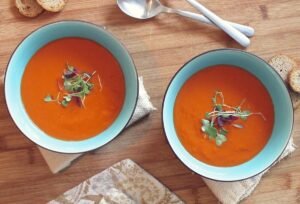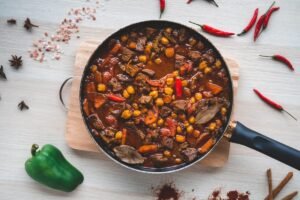6 simple and delicious recipes to reduce food waste this Christmas

Simple recipes to use up leftovers are all over the internet, but they’re often pretentious, overly-complicated, and require three months in a culinary school to pull off. Not this list. Let’s face it, if you were going to go to the effort of crafting a wellington or attempting a soufflé, you’d set out with a clear plan and a pin-point shopping list, not worrying about the courgette that’s been in the bottom of the fridge for two weeks.
My little list here is designed for the average home cook with the most rudimentary set of culinary skills and equipment. Simple recipes to use up those pesky anomalies lurking in the back of your fridge so you can rustle up something quick, easy and delicious.
Food Waste
Food waste is a growing problem facing the entire world. We need to take personal responsibility for the food we waste, rather than fretting over which governmental legislation would be best suited to eliminating the appalling amount of produce wasted every year.
Each person can do their part by reducing the amount of food we throw in the bin every week. We all do it – we’re all guilty. We put these peppers, sweet potatoes and asparagus in our shopping trolley each week with the best of intentions. “That’ll be nice in a curry,” we tell ourselves. But these once vibrant aubergines and chilis often shrivel into obscurity as we turn up our collective noses and reach for the sausages.
Waste levels are severely exasperated around the festive period, with 70% of all people admitting they spend more money than they should on food during Christmas. In Ireland alone, we over-stock so excessively that over €40 million worth of food ends up in the bin every holiday season. This article offers 6 delicious recipes to rescue Christmas leftovers from the bin.
Soup

Everybody has potatoes, rice, pasta, or flour loitering somewhere in their kitchen. But for those of you who don’t have one of these starchy, base ingredients, here’s a recipe to put a smile on any face.
Ingredients
Literally whatever vegetables you have in your fridge. It’s best to have an onion, but not necessary. Anything you have lying around, taking up space, will do – carrots, celery, peppers, mushrooms, tomatoes, broccoli, whatever. Some vegetables, like onions and leeks, better lend themselves to soup than, say, avocados or cucumbers, but it’s really hard to go wrong.
Method
- Dice all your veg into small, bitesize pieces.
- Warm some olive oil in a large pot.
- If you have onion, celery or leek, add them first. Cook on a low heat for 5 minutes.
- Add crushed garlic and bay leaf (if you have any).
- Add any hard, root veg you’re using, eg. carrots, sweet potatoes, turnips, parsnips, pumpkin, squash. Cook on a low heat for 10 mins.
- Add all remaining vegetables and cook for a further 10 mins on a low heat (if you have a stock cube, now is the time to add one or two).
- Cover with water and cook for 5 to 10 mins.
- Skim! I cannot stress this enough. There will be a white/grey/brown layer of foam congeling at the top of your soup; this is all the unwanted impurities from the vegetables. Using a ladle, carefully skim this off the top, otherwise your soup will taste sour.
- Bring to the boil then simmer on a low heat for 20 minutes.
- If you used a bay leaf, remove it now. Blitz the soup.
- Now is the time to season your soup and get the consistency that’s right for you. Add salt, pepper and a pinch of herbs. If your soup is too thick, add extra water or milk. Simmer for another 10 mins and you’re good to go!
Final tip: If you have some stale bread, dice it and toss in a pan with some olive oil, salt and garlic. Hey presto, croutons!
Stew

Stew is so simple and versatile yet so delicious. This recipe is carnivorous in nature, but if you’re vegan, vegetarian or simply don’t have any meat in your fridge, don’t worry, veggie stew is just as delicious.
Ingredients
- Whatever meat you have will do; beef or lamb work best, but chicken, pork, or even sausages will all work.
- Any vegetables you need to use will work perfectly well in this stew.
- Tomato Purée, stock cube, bay leaf (if you have any)
- Alcohol (preferably wine but beer also works {darker the better})
Method
- Dice your meat and veg into bite-size pieces.
- Heat oil in a pot. On a high heat, brown the meat on both sides, it doesn’t need to be cooked fully through.
- Remove the meat and set aside, making sure to keep the juice in the pot.
- If you have onion, celery or leek, add them first. Cook on a low heat for 5 minutes.
- Add crushed garlic, tomato purée and bay leaf (if you have any).
- Add any hard, root veg you’re using, eg. carrots, sweet potatoes, turnips, parsnips, pumpkin, squash. Cook on a low heat for 10 minutes.
- Add all remaining vegetables and cook for a further 10 minutes on a low heat (if you have a stock cube, now is the time to add one or two).
- Return your cooked meat to the pot. Add one or two cups of alcohol and cook on a low heat for 5 minutes.
- Cover with water and cook for a further 5 to 10 minutes on a low heat.
- Skim! As I said in the soup recipe, it is vital to skim off the white/grey/brown layer of foam congeling at the top of your stew.
- Season with salt and pepper to your taste and simmer for at least one hour.
Pasta

This is the quickest and easiest way to consume any Christmas leftovers tinkering on the brink of the compost bin.
Ingredients
- Pasta
- Meat (don’t waste the steak, use sausages, bacon, mice, chicken or fish)
- Any and all vegetables
- Cheese
- Milk or cream
- Wine or beer
- Tomato purée
Method
- Dice your meat and veg into bite-size pieces.
- Heat oil in a pan. Cook the meat, remove and set aside, making sure to keep the juice in the pot.
- Cook onion and garlic on a low heat for 5 minutes before adding any hard, root veg and cook on a low heat for a further 10 minutes.
- Add all remaining vegetables, add a spoon of tomato purée and cook for 10 minutes on a low heat.
- Fill a separate pot with water, add a pinch of salt and bring to the boil.
- Once boiled, add your pasta and cook for approximately 8 minutes.
- Strain the pasta and immediately add to the vegetables. Add the meat to the mix and stir.
- Quickly add one cup of milk or cream and a splash of white wine. Cook on a low heat for 5 minutes on a low heat.
- Add in the cheese and stir the mix until the cheese is fully melted.
- Season with salt and pepper.
Jambalaya

Don’t be unnerved by the name, this is just a basic, generic recipe which I could just as easily have called “fried rice” or “biryani.” It’s just rice, veg and meat. Rustic, hearty, healthy, delicious.
Ingredients
- Rice
- Meat (don’t waste the steak, use sausages, bacon, mice, chicken or fish)
- Any and all vegetables
- Wine or beer
- Tomato purée
Method
- Use two cups of water for every one cup of rice. Place the rice and water in a pot, cover with a lid and cook on a low heat for 20 to 30 minutes. Do not stir.
- Dice your meat and veg into bite-size pieces.
- Heat oil in a pan. And cook the meat. Remove and set aside, making sure to keep the juice in the pan.
- Cook onion and garlic on a low heat for 5 minutes before adding any hard, root veg and cook on a low heat for a further 10 minutes.
- Add all remaining vegetables, add a spoon of tomato purée and cook for 10 minutes on a low heat.
- Add one cup of wine. Cook on a low heat for 5 minutes on a low heat.
- Add the meat and rice to the mix, season with salt, pepper and a few chili flakes and cook on a medium heat for 5 to 10 minutes.
Pie
Only one three-letter word causes more salivation and anticipation than pie, but that doesn’t involve food… usually. Sweet or savoury, the flakey goodness of a freshly baked pie is without equal. So, as a treat, I’m giving you four mouth-watering recipes that aren’t just good for the environment, but good for your pocket as well.
Meat Pie

Ingredients
- For the pastry:
- 500g flour
- 250g butter
- ½ tsp salt
- 100ml water
- Any turkey, ham, goose or other meat still lingering from the Christmas feast.
- Any vegetables taking up space.
- Cheese
- Milk or cream
- Alcohol (white wine or beer {lighter the better})
Method
- For the pastry, sieve the flour and salt together. Dice the butter into very small cubes and rub into the flour until the mix starts to resemble breadcrumbs.
- Make a well in the centre, add the water and mix together until a smooth dough is formed. Wrap in cling film and refrigerate.
- Dice your meat and veg into bite-size pieces.
- Heat oil in a pot. If you’re using chicken, cook on a high heat until the meat is brown on both sides.
- Remove the meat and set aside, making sure to keep the juice in the pot.
- If you have onion, celery or leek, add them first. Cook on a low heat for 5 minutes.
- Add any hard, root veg you’re using, eg. carrots or squash. Cook on a low heat for 10 minutes.
- Add all remaining vegetables and cook for a further 10 minutes on a low heat.
- Return your cooked chicken to the pot. If you’re using fish or shellfish, add it now.
- Add one or two cups of milk or cream and one cup of alcohol. Cook on a low heat for 5 minutes on a low heat.
- Add in the cheese and stir the mix until the cheese is fully melted.
- Season with salt and pepper. Check for taste. Set aside.
- Lightly butter your pie tray/baking tray. On a lightly floured surface, roll out the pastry. Roll the pastry into the tray, packing it tightly (make sure to keep enough for the top of the pie).
- Prick the base of the pastry and bake for 2 to 3 minutes on the highest heat (This will prevent your pie having a soggy bottom).
- Remove the pastry from the oven. Add the filling, spreading evenly. Cover your pie with the remaining pastry and pierce a hole in the middle to allow steam to escape.
- Brush the top with a beaten egg or milk and bake at Gas 4 / 180° C / 350° F for approximately 20 to 25 minutes.
- Allow the pie to rest for at least 5 minutes before slicing.
Fruit Pie

Fruit makes up a large proportion of the fresh food we waste each week. A pie is one of the best ways to keep those fruits out of the bin. Don’t worry about a bruise or a blemish, this pie recipe will rescue the saddest looking fruit.
Ingredients
- For the pastry:
- 50g butter
- 125g sugar
- 1 egg
- 200g flour
- Pinch of salt
- Any fruit you have lying around.
- Sugar
- Vanilla or cinnamon
- Wine, whiskey or brandy
Method
- Cream together the butter and sugar until smooth. Add the beaten egg and mix into the butter.
- Sieve in the flour and salt and mix together for approximately 5 minutes until a smooth dough is formed. Wrap in cling film and refrigerate.
- Weigh all the fruit you’re going to use. Whatever the total weight is, use half that amount of sugar (so if the fruit weighs 200g, use 100g of sugar).
- On a low heat, add all the fruit, sugar and vanilla or cinnamon to a pot and cook for 10 minutes.
- Add a splash of booze and cook for 2 to 3 minutes, stirring constantly. Set aside.
- Lightly butter your pie tray/baking tray. On a lightly floured surface, roll out the pastry. Roll the pastry into the tray, packing it tightly (make sure to keep enough for the top of the pie).
- Prick the base of the pastry and bake for 2 to 3 minutes on the highest heat (This will prevent your pie having a soggy bottom).
- Remove the pastry from the oven. Add the filling, spreading evenly. Cover your pie with the remaining pastry and pierce a hole in the middle to allow steam to escape.
- Brush the top with a beaten egg or milk and bake at Gas 4 / 180° C / 350° F for approximately 20 to 25 minutes.
- Allow the pie to rest for at least 5 minutes before slicing.